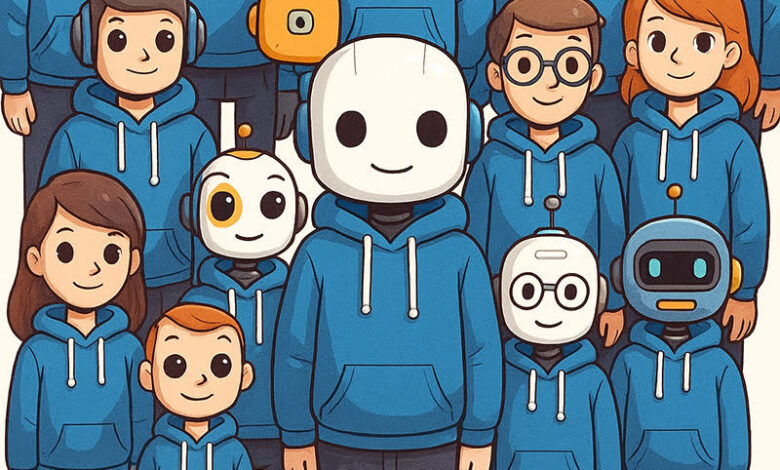
Dawn of A New Kind of Professional Worker Emerges
Across boardrooms, law firms, IT organizations shared services hubs, a quiet revolution is underway—not through new hires, but through new software. The rise of generative AI has ushered in a new class of digital workers: autonomous agents capable of planning, reasoning, and executing complex, multistep tasks with precision. These aren’t tools — they are collaborators. They are changing what it means to “do the work.”
In professional services — a sector historically powered by expertise, headcount, and billable hours — the shift is seismic. As AI becomes embedded in the delivery of consulting, legal, IT, finance, and operations work, firms are being forced to reckon with a future where scale no longer comes from staffing, but from orchestration. The new value driver isn’t manpower — it’s agentic collaboration.
From Billable Hours to Intelligent Agents
The global professional services sector represents over $20 trillion in annual spend, spanning everything from legal reviews to financial modelling, process outsourcing to strategy consulting. For decades, its business model was straightforward: clients paid for access to experts. More hours meant more value. More people meant more scale.
That equation is breaking down. The BPO market alone surpassed $300 billion in 2024 and is projected to exceed $525 billion by 2030. But many of its core functions — call center operations, claims processing, software development, reconciliations, compliance checks — are now replicable through generative AI. With new AI-native companies automating everything from customer support to legal processing, entire workflows are being replaced by intelligent, adaptive software.
What’s emerging is the age of the agentic worker — a new delivery model where autonomous AI agents not only perform tasks but coordinate with each other across systems, mimicking human-like processes without the drag of human limitations.
CEOs Must Now Lead a New Digital Workforce of AI Agents
This shift doesn’t just affect delivery teams — it redefines work itself. In a recently leaked internal memo, Shopify CEO Tobias Lütke called on his employees to think of themselves not as isolated contributors, but as orchestrators of fleets of AI assistants. In his vision, a 1,000-person company might now operate with the power of 5,000 intelligent agents — and the core job of each employee is to get results through AI.
This is the mindset shift now spreading across enterprises: AI is no longer an IT initiative. It is a re-platforming of the enterprise. And the CEO’s role isn’t just to approve experimentation — it’s to architect a new performance culture where productivity is defined not by hours worked, but by how effectively human-AI teams deliver outcomes.
The Rise of Agentic Performance
In this new model, the metric is no longer how well you do your job — it’s how well you enhance your job with AI. Workers who adapt gain exponential leverage; those who don’t risk becoming irrelevant. This creates an entirely new dimension of competitive advantage — one rooted in orchestration literacy, not institutional memory.
In a typical consulting or legal firm, junior professionals once spent hours formatting decks or reviewing contracts. Today, these tasks can be handled in minutes by fine-tuned AI agents. But rather than replace talent, this unlocks it. Freed from low-leverage tasks, professionals can focus on interpretation, strategy, and client relationships — the parts of the job where human nuance still matters most.
Infrastructure, Not Intuition
Andreessen Horowitz’s “Unbundling the BPO” analysis highlights how AI-native firms are replacing traditional outsourcing models with infrastructure-driven ones. These firms aren’t trying to hire faster — they’re building faster. Every task becomes a function. Every workflow becomes a product. Every outcome is delivered through repeatable logic.
What emerges is a radically different operating model:
- Instead of variable labor costs, you have scalable compute costs.
- Instead of training people, you fine-tune models.
- Instead of capacity planning, you orchestrate workflows.
This inversion of the traditional delivery stack makes professional services more like software — predictable, scalable, and increasingly democratized.
The End of Professional Gatekeeping?
Perhaps most transformational is the way AI breaks down access barriers. Services once limited to clients of Big Four firms or global consultancies can now be accessed via agentic interfaces — automated legal review, self-updating financial models, AI-led strategic planning. This democratization creates new winners: startups, SMEs, and global teams who previously lacked access to elite services now find themselves operating on a more level playing field.
As with cloud computing before it, the long-term impact of generative AI won’t just be speed or cost — it will be accessibility. Services that once cost $200,000 a month may soon cost $200. And they’ll run faster, too.
Human in the Loop — or Out of It?
The question now is not whether AI will be integrated into professional services — it’s how. Some firms will adopt a hybrid model, keeping a human in the loop for oversight and nuance. Others will go fully agentic, allowing workflows to execute end-to-end with minimal human intervention.
Either way, the implications for workforce strategy, leadership, and culture are profound. Every employee, from analyst to executive, must learn how to work with AI. And every firm must reimagine its core advantage — not as the number of people it can deploy, but the speed and sophistication of the agents it can orchestrate.
The Future Is Auto-generated
The future of professional services won’t be driven by bigger teams or longer hours — it will be defined by those who can build, prompt, and orchestrate AI effectively. The professional of the future won’t just do the work — they’ll delegate it to digital labor, then layer on interpretation, creativity, and trust.
For CEOs, this is a leadership moment. Like Shopify’s Lütke, the challenge is no longer just to experiment with AI — it’s to rebuild the operating model around it.
Agentic workflows are not a trend. They are the new foundation for scale, access, and productivity in the professional world. Those who embrace them will lead the next generation of firms. Those who don’t may soon find themselves eclipsed — not by a competitor, but by a constellation of autonomous agents, working quietly, tirelessly, and infinitely fast.





